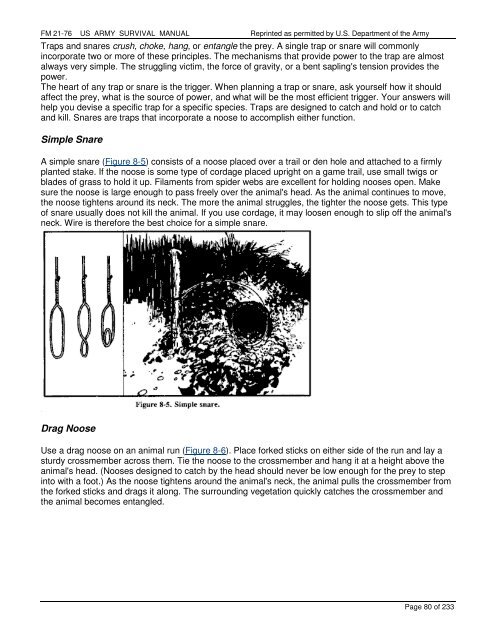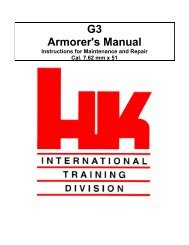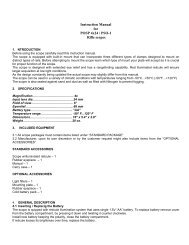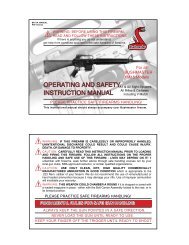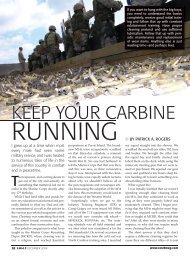FM 21-76 US ARMY SURVIVAL MANUAL - AR15.com
FM 21-76 US ARMY SURVIVAL MANUAL - AR15.com
FM 21-76 US ARMY SURVIVAL MANUAL - AR15.com
You also want an ePaper? Increase the reach of your titles
YUMPU automatically turns print PDFs into web optimized ePapers that Google loves.
<strong>FM</strong> <strong>21</strong>-<strong>76</strong> <strong>US</strong> <strong>ARMY</strong> <strong>SURVIVAL</strong> <strong>MANUAL</strong> Reprinted as permitted by U.S. Department of the Army<br />
Traps and snares crush, choke, hang, or entangle the prey. A single trap or snare will commonly<br />
incorporate two or more of these principles. The mechanisms that provide power to the trap are almost<br />
always very simple. The struggling victim, the force of gravity, or a bent sapling's tension provides the<br />
power.<br />
The heart of any trap or snare is the trigger. When planning a trap or snare, ask yourself how it should<br />
affect the prey, what is the source of power, and what will be the most efficient trigger. Your answers will<br />
help you devise a specific trap for a specific species. Traps are designed to catch and hold or to catch<br />
and kill. Snares are traps that incorporate a noose to accomplish either function.<br />
Simple Snare<br />
A simple snare (Figure 8-5) consists of a noose placed over a trail or den hole and attached to a firmly<br />
planted stake. If the noose is some type of cordage placed upright on a game trail, use small twigs or<br />
blades of grass to hold it up. Filaments from spider webs are excellent for holding nooses open. Make<br />
sure the noose is large enough to pass freely over the animal's head. As the animal continues to move,<br />
the noose tightens around its neck. The more the animal struggles, the tighter the noose gets. This type<br />
of snare usually does not kill the animal. If you use cordage, it may loosen enough to slip off the animal's<br />
neck. Wire is therefore the best choice for a simple snare.<br />
Drag Noose<br />
Use a drag noose on an animal run (Figure 8-6). Place forked sticks on either side of the run and lay a<br />
sturdy crossmember across them. Tie the noose to the crossmember and hang it at a height above the<br />
animal's head. (Nooses designed to catch by the head should never be low enough for the prey to step<br />
into with a foot.) As the noose tightens around the animal's neck, the animal pulls the crossmember from<br />
the forked sticks and drags it along. The surrounding vegetation quickly catches the crossmember and<br />
the animal becomes entangled.<br />
Page 80 of 233


